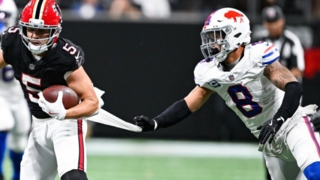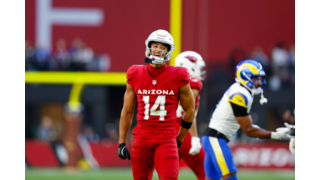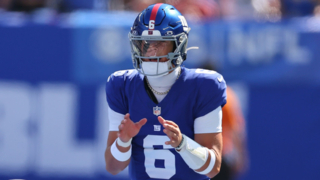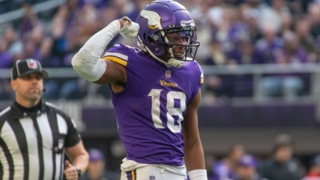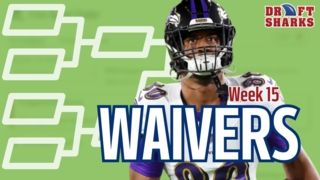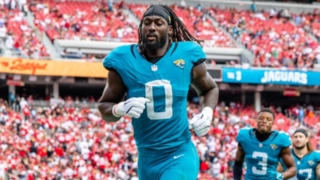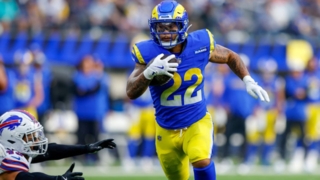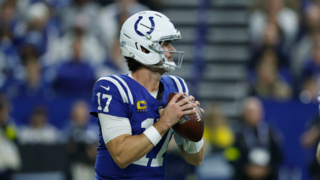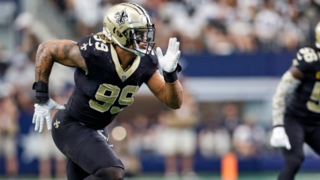2018 First-Round Bust

Well, who would you pick?
Every summer we stare at the list of 12 names commonly going in Round 1 of fantasy football drafts. And it’s rarely easy to single out the guy that we’re going to convince you not to pick. This year has seemed particularly difficult, though.
So much looks similar among the 4 workhorse backs at the top of most boards. Then come exciting youngsters Alvin Kamara and Saquon Barkley in the middle of the round, with last year’s top 2 fantasy wideouts -- Antonio Brown and DeAndre Hopkins -- sprinkled somewhere in the vicinity.
And the final third holds the stud WR who shouldn’t be able to keep replicating his big numbers, but Odell Beckham just does (when healthy). He’s surrounded by a trio of RBs all 25 or younger who spent 2017 dominating their backfields in touches.
One or 2 of these guys will punch you in the gut after you spend a 1st-round pick on him this summer. But whom?
What Makes a Bust?
I started my process for this year’s selection by looking back over the past 10 years to see what has characterized recent busts. First of all, what makes you a bust? Well, that’s obviously at least somewhat subjective and open to debate, but here’s what I found.
RB scores fall off more precipitously than those at WR. That probably matches what most of us believed, but it’s good to confirm rather than just assume.
I took the median score for each spot in the top 50 at RB and WR over the past 10 years. At RB, each of the top 9 spots scored at least 3 more fantasy points per game vs. the player 10 spots below. (After the top 9, that gap shrank.) Over at wideout, just the top 6 spots presented gaps of 3+ fantasy points per game. When I compared the top 40s for each position, just 1 ranking spot found the corresponding WR beating the corresponding RB in scoring gap.
That’s a lot of words. But it basically means that you lose more points by waiting for a RB than a WR. (Obviously depending on who you actually pick.)
The 10-spot gap makes for a good, loose “bust” definition here.
Over the past 10 years, 36 of the 120 players considered 1st-rounders by PPR ADP -- I used MyFantasyLeague.com -- finished the season 10+ spots lower in the rankings vs. their positional ADP. Of those 36, 19 missed 3+ games in their “bust” seasons. Getting hurt is obviously the easiest way for a player to bust. But that also means that 17 of the 36 missed 2 games or fewer (and we saw plenty of guys not bust while losing a game or 2 to injury over that span).
The 17 who busted despite playing at least 14 games included 11 RBs and 6 WRs. Seven of those 17 players busted while missing no games:

Richardson and 2010 Moss played their way off rosters in their bust seasons. That’d be tough for any of us to forese. At RB, McCoy saw his touches dip a bit but mostly suffered from a slow start that dragged his full-season numbers down (plus a coaching staff that cut his red-zone work). Gurley had the misfortune of playing for the 2016 Rams. If Jeff Fisher knew how bad that offense would be, he might have fired himself before the season.
Robinson and Hopkins endured huge efficiency dips that more of us should have foreseen because of their weak QB situations (and TD luck the previous year). While 2008 Moss became human after a superhuman (23 TDs) 2017.
Robinson was the only WR in this list who didn’t see a decrease or more than 2 targets per game in his bust season. All saw their offenses rank 7+ spots lower in scoring vs. the year before. The 3 RBs lack a common thread.
Looking back over the 8 “bust” RBs who missed 1 or 2 games, however, reveals a bevy of players who:
-- dealt with nagging injuries that likely inhibited performance
-- saw their offenses decline, or
-- endured a decrease in touches.
Overall, that initial group of 36 busts included 24 RBs. That’s 67%, compared with the 56.7% share that RB holds among the total 120 first-round spots over the past 10 years (in 12-team leagues, obviously).
WRs constituted 29.2% of the 1st-rounders, 27.8% of the “bust” list. The 15 QBs plus 2 TEs produced just a pair of QBs in the “bust” category (5.6% of busts; 14.2% of the total 1st-round pool). But we’re not drafting QBs this early because of relative value at the position. (TE might be another story, depending on your format.)
So we settled on a RB, which shouldn’t surprise you given that they take up 9 of the 12 positions in Round 1 ADP.
The name, on the other hand, probably will surprise you. He doesn’t come waving a glowing red flag, but rather surrounded by question marks that work together to cloud his outlook.
The Pick
Selecting Chiefs RB Kareem Hunt in the 1st round isn’t crazy. The guy finished his rookie season 4th in the PPR rankings at RB, 3rd on the non-PPR side. He plays for longtime offensive guru Andy Reid, who has given us Brian Westbrook, LeSean McCoy and Jamaal Charles’ last 2 meaningful seasons. And Hunt will continue to lead the backfield in an offense with lots of intriguing talent. But there are reasons for concern.
Stripping Away Injury Risk
You know what? The easiest move here probably would have been to pick Leonard Fournette, point out that he has lost time to ankle injuries each of the past 2 years and shrug if he managed to stay healthy. Fournette does sit tied for 2nd-highest probability of injury among RBs in Sports Injury Predictor’s rankings. And that means he leads all 1st-rounders in injury risk. If you’re not comfy with that, you can certainly pass on him. But Fournette’s a good example of why we add replacement points into our projections.
He finished his rookie season top-9 across fantasy formats despite missing 3 contests (2 to injury, 1 to team suspension). Fournette has reported to training camp lighter than he was at last spring’s pro day. Perhaps that doesn’t wind up affecting his ankle health, but it at least indicates the work he has put in this offseason.
Most importantly, Fournette will dominate the backfield touches for 1 of the league’s most run-heavy teams. And his main competition for red-zone carries -- Chris Ivory -- is gone.
On the injury front, no other 1st-rounder landed in a particularly worrisome range when we reviewed the SIP numbers.
Beware 2nd-Year RBs?
The past 10 years have seen 10 second-year RBs carry 1st-round ADPs, and that group hasn’t fared particularly well in delivering on draft position.

Martin had the excuse of losing 10 games to injury. Only 2 other guys missed any time, however. Elliott’s 6-game suspension makes it impressive that he still landed within the top 12. Lynch missed 1 game, but also ranked just 15th in points per game in 2008.
The whole group produced a median dip of 7 ranking spots from positional ADP to finish. That doesn’t quite reach our “bust” definition from earlier, but it’s also not what you’re looking for in a 1st-round pick.
Hunt, Kamara and Fournette all enter their 2nd seasons in September, though. So we’ll need more to support the Hunt selection. And we have it.
The Workload
Hunt logged the 6th-most carries in the league as a rookie, despite basically sitting out Week 17 (one carry) after the Chiefs clinched their playoff seed. His 67.2% share of Chiefs rushing attempts ranked 3rd in the league. And if you take out Week 17, that number jumps to 71.7% -- which would have trailed only Le’Veon Bell’s league lead.
That’s a big load … much bigger than Andy Reid RBs tend to bear.
In fact, across his 19 years as an NFL HC in Philly and then K.C., Reid backs (removing 2005, when Jamaal Charles’ Week 5 ACL tear screwed up the numbers) have produced a median of 15.9 carries per game. That’s 2.2 fewer per contest than Hunt enjoyed as a rookie.
Over that span, only 3 other Reid RBs reached 60% carry shares for their teams: LeSean McCoy (60.7%) for the 2011 Eagles, Brian Westbrook (66%) for the 2007 Eagles and Duce Staley (76.7%) for the 1999 Eagles (Reid’s HC debut).
Charles’ high mark for Reid’s Chiefs was 58.6% in 2013, Reid’s 1st season.
Hunt was headed for a work share in 2017 before Spencer Ware tore 2 knee ligaments in an August preseason game. Ware’s not going to contend for anywhere near the share he likely would have commanded last year, but Reid said this week that Ware’s ready for the start of camp.
We’ll see exactly what we get from the repaired RB, but just about any version would make for a bigger challenge than last year’s backfield presented to Hunt.
What About the Receiving?
Hunt should be set up for nice receiving numbers under Reid, at least, right? Well, just 10 RBs in the league last year beat the 12.4% team target share than Hunt tallied over his 15 full games. Even that solid number would have ranked just 11th among the lead pass-catching RBs on Reid’s 19 NFL offenses. But Reid has had a RB rank among his teams’ top 3 in targets 11 times, including Hunt last season. And that doesn’t appear likely in 2018.
Hunt edged WR Albert Wilson by a single target for 3rd on the team in 2017, after Ware had gone down and likely aided by WR Chris Conley’s Week 5 Achilles’ tendon rupture.
The 2018 Chiefs return target leaders Travis Kelce and Tyreek Hill (now entering his 3rd year), plus free-agent WR Sammy Watkins -- and, of course, a healthy Ware in the backfield.
The Watkins move signals a continued lean toward the pass, which the Chiefs have increased the past 2 seasons. Last year’s 58.9% rate of passing plays (sacks + attempts) among total offensive plays marked the largest in Reid’s 5 Chiefs seasons. That and the 58.4% of 2016 fall in line with Reid’s career median of 58.4% in that category.
As for the backfield challenge, Ware’s lone season of starting duty produced a #8 ranking among RBs in Football Outsiders’ receiving DYAR; #2 in receiving DVOA.
Reid also hasn’t gone out of his way to target RBs in the passing game since Charles went down. After healthy target shares for the position in his first 2 K.C. campaigns (with a healthy Charles), the Chiefs have ranked 26th, 24th and 15th in RB target share the past 3 years.
Hunt tied for 12th in receptions (53), ranked 8th in receiving yards (455) and tied for 6th in TD catches (3) among RBs in 2017. He’ll have a hard time matching any of those totals in 2018.
Pass protection could present a further challenge to Hunt's playing time. He entered the league to concerns about a lack of college experience in that area, with Toledo plying him almost solely as a receiver in the passing game. The rookie then checked in just 39th among 46 qualifying RBs in Pro Football Focus' pass-blocking grades last year. Ware fared much better in 2016, ranking 15th out of 58 qualifiers.
That blocking could prove even more important in 2018, with Kansas City breaking in a new QB.
How Good Will the Offense Be?
Last year’s Chiefs ranked 5th in total yards, 2nd in yards per play and 6th in points. Just 1 of those rankings fell in line with the previous 4 seasons.

Reid’s Chiefs have fared well with scoring efficiency, but they’ve been more like league-average at moving the ball. Now they add the challenge of switching from steady veteran Alex Smith to 1st-time QB starter Patrick Mahomes.
We love the talent on Mahomes, and the Chiefs clearly had enough confidence in him to trade away Smith after a division-winning season. But expecting the 2nd-year passer to keep the offense up at 5-year-high levels seems unfair -- especially against a schedule that looks like 1 of the more challenging from a QB standpoint.
Further challenging the offense’s production is a play pace that has ranked among the slowest in the league lately. The Chiefs have finished 28th or lower in situation-neutral pace for 4 straight years, according to Football Outsiders -- including 3 seasons of ranking 30th or lower.
That’s not necessarily a negative for the team on the field, but it means fewer plays every game and thus fewer chances to accrue fantasy points.
Finally, the Chiefs have also ranked 18th or lower 4 of the past 5 years in offensive variance, according to Football Outsiders -- including a #28 finish in 2017. That means Reid’s Chiefs have generally ranked among the NFL’s less predictable in offensive performance.
The Red Zone
More (most?) worrisome for Hunt might be those final 20 yards of field that we fantasy owners live for.
Hunt delivered big fantasy numbers as a rookie despite not faring too well in the red zone. There were 62 RBs who scored at least 2 rushing TDs in 2017. That group scored 81.5% of its TDs from inside the red zone. Hunt, meanwhile, tallied just 62.5% of his ground scores from that range -- ranking 45th. And recent Chiefs history doesn’t paint an optimistic picture for 2018.
Reid’s Chiefs hammered the goal line their 1st 2 years, following Charles to rankings of 5th (in 2013) and 9th (in 2014) in TDs per red-zone trip. The past 3 squads, however, have ranked 14th, 30th and 29th.
Dating back to his time in Philly, those 2 Charles-led teams mark the only Reid offenses among the past 11 to rank better than 14th in TDs per red-zone trip. The median finish over that 11-year span: 21st.
Reid offenses also haven’t traditionally looked to the run game to carry their scoring. Among his 19 NFL squads, just 6 have ranked higher than 15th in the percentage of points coming from rushing TDs. The 19 teams have averaged a #16 ranking, with a median of 17th.
Add to that Reid’s frustrating tendencies with his lead backs near the goal line in K.C. The whole team logged just 9 rushing attempts inside the 5-yard line last year. Nine individual players and 28 teams had more. In 2016, Ware tied for 22nd in team share of carries inside the 5-yard line; 38 players ran for more scores in that range than he did. Even back in 2014, a healthy Charles garnered just 6 carries inside the 5 vs. 9 for teammate Knile Davis.
Conclusion
It’s easy to get excited as you review a rookie season that propelled Kareem Hunt from expected timeshare to top-4 fantasy RB. It’s easy to look at the exciting new QB and shiny free-agent addition at WR and expect the offense to get even more explosive.
But the numbers and the situation give us plenty of reasons for pause as we consider Hunt in the 2nd half of Round 1. And we haven’t even mentioned the other guys around him in ADP. Leonard Fournette and Melvin Gordon present similar workload profiles, with each arguably a safer bet to dominate his backfield’s touches. In Gordon’s case, you can also point to a longer record of production and a veteran QB.
And if this whole RB trio makes you a little queasy, then Julio Jones, Odell Beckham and Michael Thomas greet you at WR, with RBs such as Dalvin Cook, Joe Mixon Jerick McKinnon, Christian McCaffrey and Devonta Freeman amid the next 12 in ADP. Upside RB options then reside in the Round 3-8 range -- multiple players who don’t require an injury to a teammate to open up early-season opportunity.
Hunt relied on more long-distance scores than the typical RB last year. He feasted on a situation that delivered value to his doorstep. He won’t find the road to success quite so inviting in 2018.
Draft using the best dynamic tool in the industry. Our fantasy player valuations (3D Values) change during your draft in response to...
- Exact league settings - direct sync
- Opponent and Team Needs
- Positional scarcity & available players
- Ceiling, injury risk, ADP, and more!
You need a dynamic cheat sheet that easily live-syncs with your draft board and adapts throughout your draft using 17 crucial indicators.
Get your Draft War Room Today
 Redraft
Redraft Dynasty
Dynasty Best Ball
Best Ball